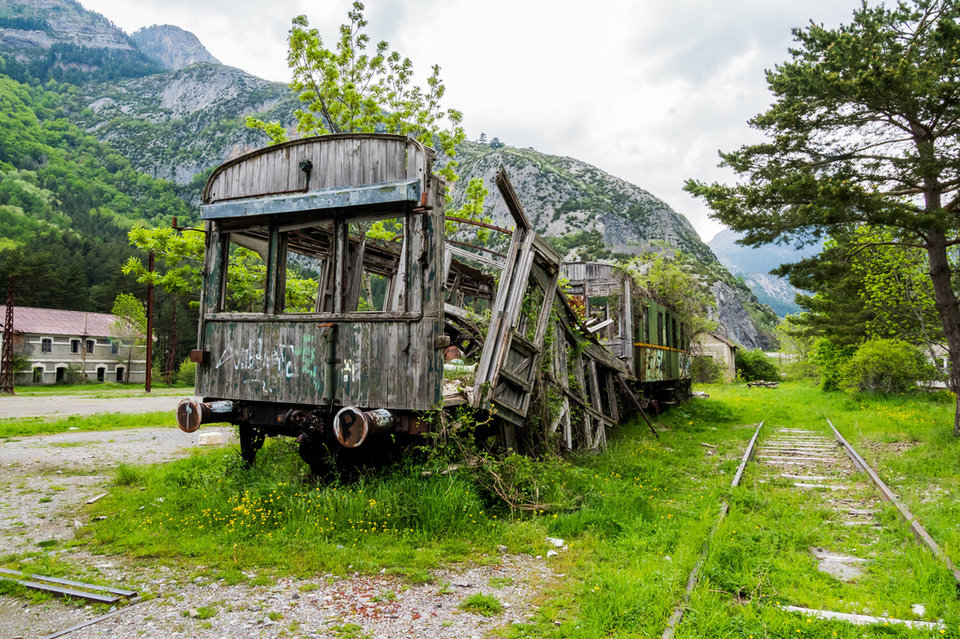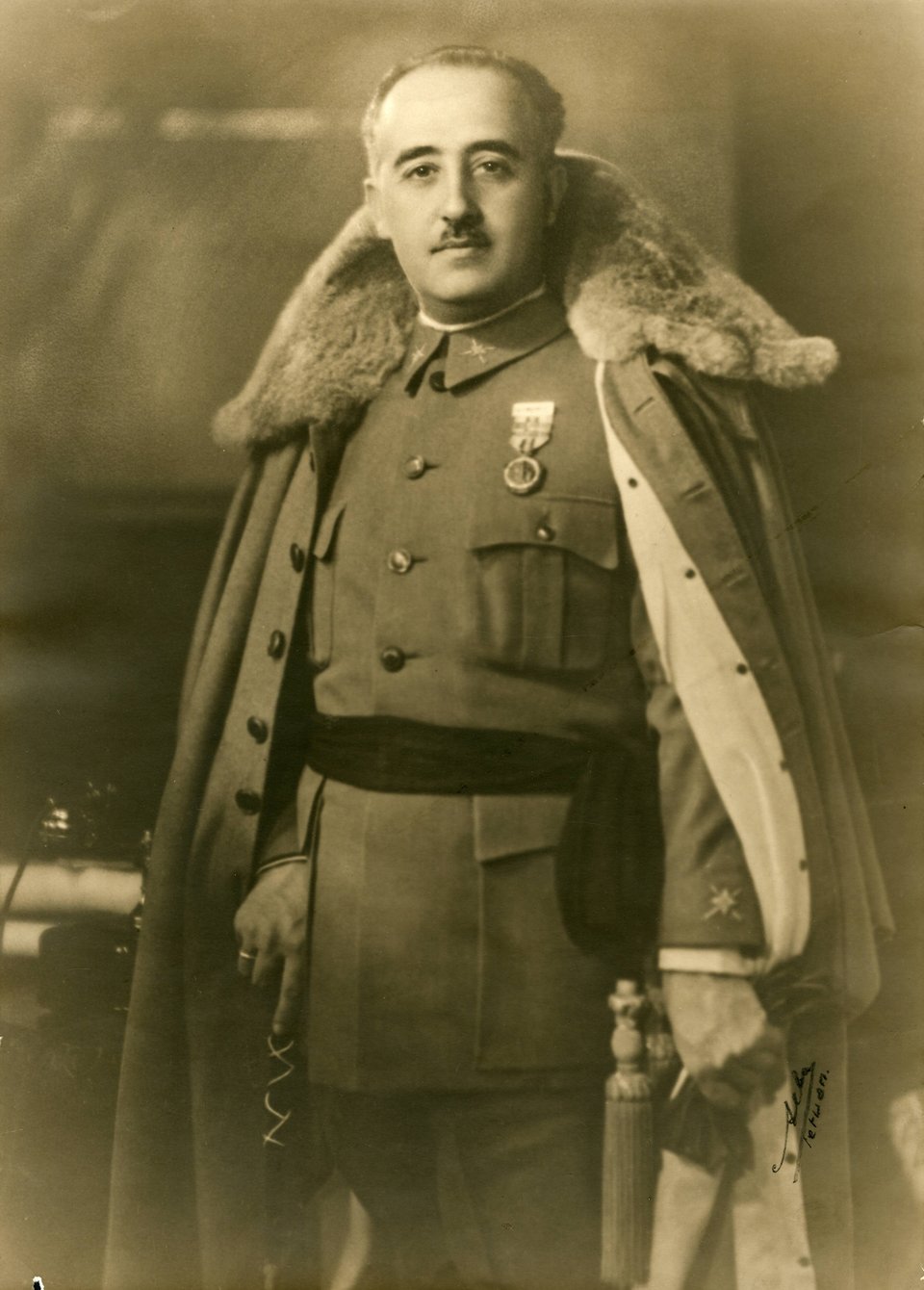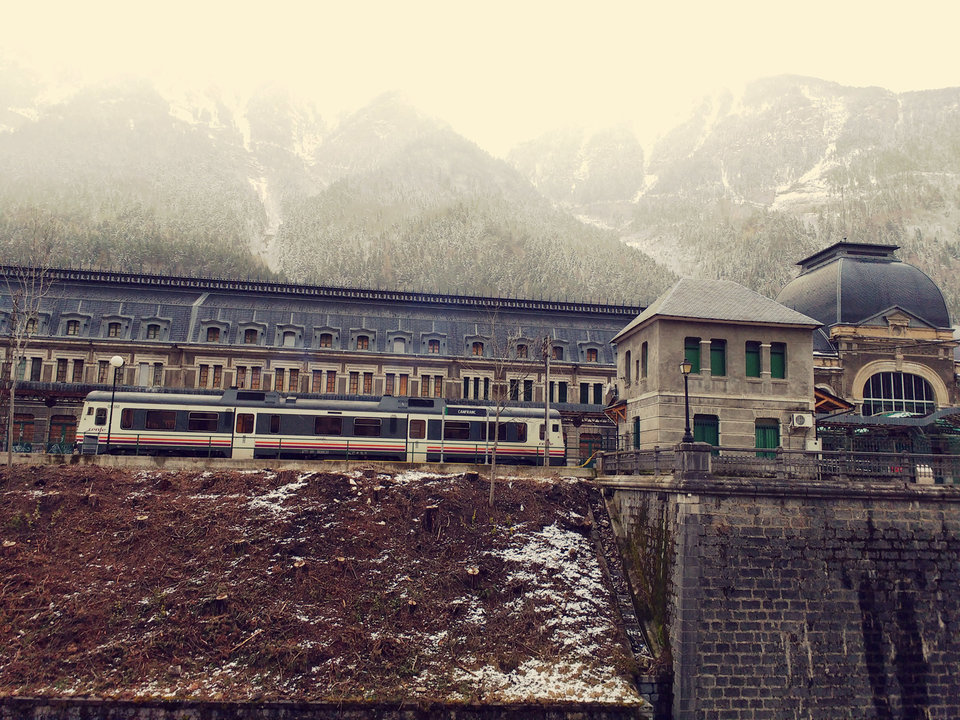The eclectic Beaux-Arts style chosen for the exterior was inspired by the culture of French palatial architecture.
How Canfranc came to life
In 1853, the Spanish and French governments agreed to boost their trade links via a new rail line. “Spain had two main border crossings with France since the origins of the railway and the demand for a third border crossing was constant during the second half of the 19th century,” explains Alfonso Marco, a historian and technician for the Subdirectorate of Technological Innovation at Spanish railway infrastructure manager Adif.
“A railway so desired should have a station at the same level that would also show Spain’s ability to face and complete a complex project such as the Canfranc railway with its monumental station, located in what until then was a virgin Pyrenean valley,” he continues.

A recreation of the station’s opening in 1928 at the station’s 90th anniversary celebration in 2018
In his book ‘El Canfranc, Historia de un tren de leyenda’ (translated: ‘The Canfranc, story of a train of legend’), Marco - who was himself born from a family of rail workers in Canfranc - writes that the cost for the project was estimated at 3.2 million pesetas (the rough equivalent of €20,000), plus over 1.2 million (€7,200) to build access points, docks and other facilities.
According to Miguel Muñoz Rubio, a historian at the Madrid Museum of Railways (itself of the Foundation of Spanish Railways), the investment was justified by a number of practical and stylistic reasons.
“Firstly, unlike other border crossings, where each country builds its own station, it was decided here that there should be only a common one,” he says. “[This] forced authorities to use a larger scale, since it duplicated all the necessary facilities.” The location of the hub also played a key role in its design.
In addition, the growing popularity of the railways called for the construction of “a building capable of making a symbolic impact”, Muñoz Rubio continues. “For this reason, the eclectic Beaux-Arts style chosen for the exterior was inspired by the culture of French palatial architecture, while the interior was designed with all the recognisable elements of classical Roman architecture.”
Works to build this colossal hub, which soon became the second biggest station in Europe, were eventually concluded in 1928. Now as then, Marco says, its reputation precedes it: “In its monumentality, it combines the technological with the artistic and since it was built it has become a kind of railway ‘mecca’ for its beauty and emblematic character.”
Canfranc at war
Despite the fanfare around its construction and inauguration, Canfranc’s lustre did not last long. Only three years after opening, a blaze broke out in the lobby and propagated throughout the surroundings, causing damages estimated at 500,000 pesetas (€3,000).
As both Marco and Muñoz Rubio argue, this was the beginning of the end for Canfranc.
Although experts are yet to agree on this matter, Muñoz Rubio explains that the episode probably earned Canfranc the nickname of ‘Titanic of the Mountains’. Some historians, like Marco, hypothesise that the station’s “monumental and enormous” structure was easily comparable to that of the ill-fated ship, which sank just over a decade before Canfranc’s opening.

A dilapidated train carriage outside Canfranc station.
Yet others share more pessimistic views. “There are historians and journalists who maintain that it began to be named that way after the fire the station suffered in 1931, because, since then, all the hopes placed on the station vanished,” says Muñoz Rubio. “But I have to admit that I have not been able to find out when it was first used.”
But before this happened in the 1970s, Canfranc played a key role in the years of the Second World War. As Spanish newspaper El Pais puts it, the station and its city became a ‘Casablanca in the Pyrenees’, a key crossing point for goods and the epicentre of espionage for Nazi and Spanish authorities.

Spanish dictator Francisco Franco in 1930. Image: Wikimedia Commons | Biblioteca Virtual de Defensa
“Canfranc only had particular importance during the Second World War, since it was one of the paths that [Spanish dictator Francisco] Franco used to supply raw materials and food to Nazi Germany,” explains Muñoz Rubio.
“It was also used by the Spanish dictator to bring in the gold he bought in Switzerland with the foreign currency he obtained from the tungsten trade he maintained with the Allies. Finally, it was one of the main points of passage for the network of spies created to apprehend and remove members of the Resistance, Jews and, above all, the British military, from France.”
[Canfranc] was one of the main points of passage for the network of spies created to apprehend and remove members of the Resistance, Jews and, above all, the British military, from France.
The history of the Canfranc line never was a [successful one] and the station and the line were frequently threatened.
A fatal setback
Traffic briefly returned to normality in the aftermath of the war, as the station found stability between the 1950s and 1960s. But this period of prosperity was rather short-lived.
“The history of the Canfranc line never was a [successful one] and the station and the line were frequently threatened, especially since the 1960s, given its poor results,” says Marco. “Chronically underfunded, there were frequent incidents of all kinds.”
The final blow came in March 1970 when a “relatively minor accident” raised safety concerns on the line. As Marco explains, one day a freight train derailed from tracks, hit a bridge and demolished it: “The bridge could have been replaced without problems, but the temporary suspension of the service gave the opportunity to close a line that France was no longer interested in.”
This proved fatal for Canfranc station and the local population, which was severely hit by the cease in traffic. Since then, the hub has remained almost completely inoperative. “Until today, Spanish trains continue to arrive at the Franco-Spanish border,” says Marco. “So, actually the station has not stopped providing service. Of course, we are using a very small part of the facilities, very far from the purpose for which it was conceived.”
A reopening is on the cards
The Government of Aragon has been planning to restore Canfranc for years and now that French officials are sharing this desire, the station could soon regain its original splendour.
“Several years ago, the station itself and the entire Canfranc railway complex began to be rehabilitated,” says Marco. Restoration works are currently focused on two main projects: the reopening of the international line, which Marco says will have consequences for Spain and France, and the rehabilitation of the station for its “enormous historical and monumental value”.
According to local media, a landmark event took place in February, when the European Commission approved subsidies that will help Spain with the renovation of the line, in what was labelled a “giant step towards reopening”.

90th anniversary of Canfranc Railway Station. Image: VICTOR TORRES | Shutterstock.com
As for the station itself, the Aragon Government is working to convert its wide spaces into a five-star hotel with 104 rooms. According to the official Canfranc station website, work to rehabilitate the area - which was declared a Site of Cultural Interest in 2007 - is already underway and is currently focusing on the external facade.
It was expected to be completed by the first quarter of 2020, though a recent tweet from the Canfranc Tourism Office suggests that efforts have slowed down due to the coronavirus pandemic. In the meantime, a smaller and more accessible rail station is also being built nearby.
Yet irrespectively of when and how Canfranc will reopen, the local population is determined to bring it back. “The Canfranc International Station has always been an icon for the Aragonese, its recovery and the reopening of the line, a common goal, a collective dream,” reads the Canfranc station website.
“Its recovery is a moral obligation with the generations of Aragonese who preceded us, who invested 75 long years in turning into reality a dream that began [...] in 1853 and was fulfilled with the inauguration of the station on 18 July 1928.”
The Canfranc International Station has always been an icon for the Aragonese.
